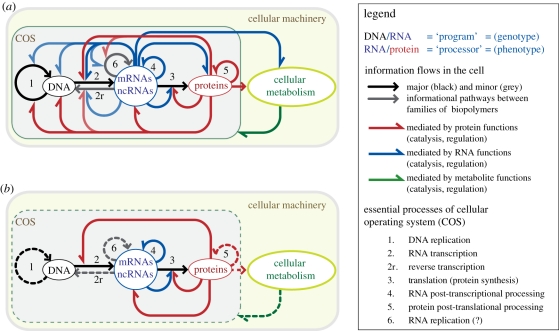Figure 2.
Flow of information within the central dogma of a cell. The diagram in (a) conceptualizes and summarizes the different pathways and feedback loops that relate to the three major categories of informational polymers involved in the COS. ncRNAs, non-coding RNAs; mRNAs, messenger RNAs (coding for proteins). RNA replication (step 6) is a process that occurs in eukaryotic cells [38,39]. It might also occur in bacteria. The cellular metabolism can theoretically have an informational effect on any of the COS (this is indicated by a green arrow directed from the cellular metabolism to the COS). (b) Simplified diagram with information feedback loops involved in the processing of ncRNAs that directly participate in translation (e.g. rRNA, tRNA). Dashed arrows indicate steps that are not essential to the process. The gene corresponding to the ncRNA is transcribed (step 2) into a ncRNA precursor that might require post-transcriptional processing (step 4), so it can be used by the translational apparatus for synthesizing proteins (step 3). Translation (step 3) is possible only when the information encoded at the level of the ncRNA gene is valid. The quality of the information carried by the ncRNA is necessary for the production of the enzymes responsible for the production of the mature ncRNA, like the RNA polymerase (step 2), the proteins of the translational apparatus (step 3) and the proteins involved in the maturation (step 4). This feedback loop controls the quality of the informational properties of the ncRNA.

